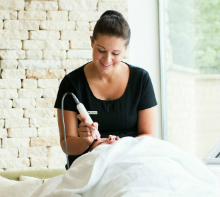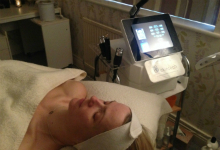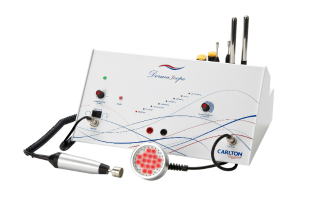Which facial lifting machine is right for your business?
Collagen stimulation, skin rejuvenation and facial lifting are all buzzwords that are driving the trend for machine-based facial treatments. And with an ever-growing list of machines being brought to the market, and savvy clients demanding visible, lasting results, ignoring this trend would be a mistake. But a machine is a big investment, whether you’re a mobile therapist or a large spa chain, so where do you start when it comes to choosing one? Not all machines are right for all types of spa or salon, so we did the hard work for you and quizzed four very different businesses on how they approached buying a machine, and how to make this investment a success.
Case Study 1: The Residential Spa
Calcot Spa in Gloucestershire was an early adopter of the machine route, taking on its first Caci machine 11 years ago, and upgrading to the newer Caci Ultimate (£10,000) more recently. “We have three distinct markets here: hotel guests, day spa guests and locals who come for individual treatments,” says spa director Cathy Ball. “That last group makes up about 20% of our business so I knew from the start we needed more of a salon offer for them.”

Case Study 2: The Medi-Spa

For the new Cavendish Clinic & Medi-Spa in London’s Parsons Green, which opened last September, introducing the LPG Endermolift machine (£14,000) to its list of treatments was a no brainer. The team says it fits well with the type of treatments they offer and is well suited to their target market of clients – working women and busy mums. The machine has so far proved popular among clients aged between 30 and 60 and marketing has initially been targeted at clients who already have the clinic’s microdermabrasion treatments. “Clients particularly like the contouring aspect; they say it’s actually quite relaxing and the results are visible straightaway, which makes it an easy sell,” says Aga Tracz, senior medical esthetician at Cavendish.
And as well as targeting existing clients, Cavendish has capitalised on the local businesses in the area to attract new clients. “We’ve teamed up with the hairdressing salon next door and offered vouchers to its clients for a complimentary 30 minute treatment. The voucher was also promoted on our website to drive traffic online.” The clinic changes £50 for the face or £30 for the eye area, with a full 30-minute treatment costing £70. Cavendish also offers a package of 12 treatments for the price of 10.
Case Study 3: The Local Salon

With so many clients after tangible results from their treatments – and willing to pay for them – machines are fast becoming a common feature among high street salons. But when quality hardware doesn’t come cheap, it’s not surprising that many want more bang for their buck. Natalie Davies, owner of The Beauty Centre in Surrey, chose the 3D-Skintech facial machine (£10,000) from 3D-Aesthetics for her salon.
The 4-in-1 machine offers microdermabrasion, radiofrequency, mesotherapy, and LED technology. “The majority of clients always come to me for machine-based treatments, and this one definitely offered the next level in treatment,” says Davies. “From the moment I got this machine they wanted to have it,” adding that she has had no need to advertise. “I rely heavily on word of mouth; but it’s been really well received,” she says. Davies recommends her clients take a course of six treatments over a one-month period, and charges around £125 per 75 to 90-minute session.
Case Study 4: The Home Therapist

Being a one-woman enterprise doesn’t have to mean you’re priced out of the machines market. Louise Scott, a Lincoln-based therapist who offers treatments from her home two days a week to fit around her young family, started offering her first machine treatment at the start of this year. “I’ve been self-employed for about four years and it was getting to the point where I knew my clients wanted something extra,” she explains. “It is a big cost, but it was either risk my clients going somewhere else or take the plunge and do it myself.”
Scott purchased the Derma3cope (£2,425) from Carlton Beauty and Spa for her business Beauty by Louise, with treatments including microcurrent, microdermabrasion and colour therapy. By the time she launched the treatments in January, she already had an excited client base waiting to try it.
And although the clients choosing the machine facials were already on Scott’s books, the new treatments are pricier than her traditional hands-on facials, so she’s beginning to see a return on her investment only weeks after taking it on. “They’re booked in for courses of 12, so I’m hoping I’ll make my money back quite quickly,” she adds.
Image credits: (from top) Calcot Spa, Cavendish Clinic & Medi-Spa, The Beauty Centre and Beauty by Louise
Collagen stimulation, skin rejuvenation and facial lifting are all buzzwords that are driving the trend for machine-based facial treatments. And with an ever-growing list of machines being brought to the market, and savvy clients demanding visible, lasting results, ignoring this trend would be a mistake. But a machine is a big investment, whether you’re a mobile therapist or a large spa chain, so where do you start when it comes to choosing one? Not all machines are right for all types of spa or salon, so we did the hard work for you and quizzed four very different businesses on how they approached buying a machine, and how to make this investment a success.
Case Study 1: The Residential Spa
Calcot Spa in Gloucestershire was an early adopter of the machine route, taking on its first Caci machine 11 years ago, and upgrading to the newer Caci Ultimate (£10,000) more recently. “We have three distinct markets here: hotel guests, day spa guests and locals who come for individual treatments,” says spa director Cathy Ball. “That last group makes up about 20% of our business so I knew from the start we needed more of a salon offer for them.”

Case Study 2: The Medi-Spa

For the new Cavendish Clinic & Medi-Spa in London’s Parsons Green, which opened last September, introducing the LPG Endermolift machine (£14,000) to its list of treatments was a no brainer. The team says it fits well with the type of treatments they offer and is well suited to their target market of clients – working women and busy mums. The machine has so far proved popular among clients aged between 30 and 60 and marketing has initially been targeted at clients who already have the clinic’s microdermabrasion treatments. “Clients particularly like the contouring aspect; they say it’s actually quite relaxing and the results are visible straightaway, which makes it an easy sell,” says Aga Tracz, senior medical esthetician at Cavendish.
And as well as targeting existing clients, Cavendish has capitalised on the local businesses in the area to attract new clients. “We’ve teamed up with the hairdressing salon next door and offered vouchers to its clients for a complimentary 30 minute treatment. The voucher was also promoted on our website to drive traffic online.” The clinic changes £50 for the face or £30 for the eye area, with a full 30-minute treatment costing £70. Cavendish also offers a package of 12 treatments for the price of 10.
Case Study 3: The Local Salon

With so many clients after tangible results from their treatments – and willing to pay for them – machines are fast becoming a common feature among high street salons. But when quality hardware doesn’t come cheap, it’s not surprising that many want more bang for their buck. Natalie Davies, owner of The Beauty Centre in Surrey, chose the 3D-Skintech facial machine (£10,000) from 3D-Aesthetics for her salon.
The 4-in-1 machine offers microdermabrasion, radiofrequency, mesotherapy, and LED technology. “The majority of clients always come to me for machine-based treatments, and this one definitely offered the next level in treatment,” says Davies. “From the moment I got this machine they wanted to have it,” adding that she has had no need to advertise. “I rely heavily on word of mouth; but it’s been really well received,” she says. Davies recommends her clients take a course of six treatments over a one-month period, and charges around £125 per 75 to 90-minute session.
Case Study 4: The Home Therapist

Being a one-woman enterprise doesn’t have to mean you’re priced out of the machines market. Louise Scott, a Lincoln-based therapist who offers treatments from her home two days a week to fit around her young family, started offering her first machine treatment at the start of this year. “I’ve been self-employed for about four years and it was getting to the point where I knew my clients wanted something extra,” she explains. “It is a big cost, but it was either risk my clients going somewhere else or take the plunge and do it myself.”
Scott purchased the Derma3cope (£2,425) from Carlton Beauty and Spa for her business Beauty by Louise, with treatments including microcurrent, microdermabrasion and colour therapy. By the time she launched the treatments in January, she already had an excited client base waiting to try it.
And although the clients choosing the machine facials were already on Scott’s books, the new treatments are pricier than her traditional hands-on facials, so she’s beginning to see a return on her investment only weeks after taking it on. “They’re booked in for courses of 12, so I’m hoping I’ll make my money back quite quickly,” she adds.
Image credits: (from top) Calcot Spa, Cavendish Clinic & Medi-Spa, The Beauty Centre and Beauty by Louise

